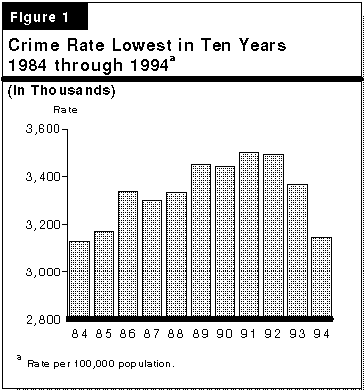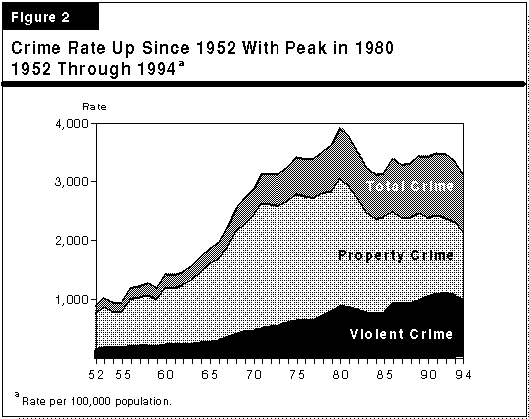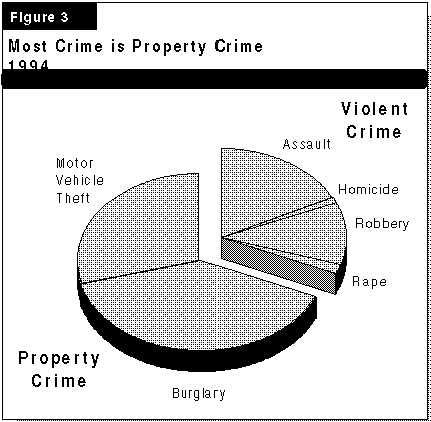

The California Department of Justice (DOJ) recently released the state's 1994 crime statistics, which show that reported crime in California hit a ten-year low in 1994. In this issue of Cal Update, we discuss the 1994 crime rate, the long-term trends in the rate, and changes in crime rates among the state's larger cities and counties.
1994 Rate Is Lowest in Ten Years. California's crime rate dropped by 6.5 percent between 1993 and 1994, and represents the lowest rate for the state since 1984, as shown in Figure 1. California's overall crime rate for 1994 was 3,147.7, meaning that there were about 3,148 reported crimes per 100,000 Californians in 1994.

During 1994, California experienced decreases in all six crimes that are part of the California Crime Index (CCI). The CCI is the state's official measure of crime containing reported incidents of four types of violent crime (homicide, rape, robbery, and assault) and two types of property crime (burglary and motor vehicle theft). In addition, two other types of crime that are counted in federal crime statistics--larceny-theft and arson--declined as well in 1994.
Long-Term Trends Show Substantial Increases in Crime. Despite the short-run trends, California's crime rate over the long run is up substantially from the 1950s and 1960s. The 1994 crime rate is about 82 percent higher than it was in 1964, and 250 percent higher than in 1952 (the first year that the DOJ began publishing statistics). However, it should be noted that California's crime rate peaked in 1980, declined for four years and began to increase through the late 1980s. In the 1990s, the rate has been declining and the 1994 rate continues this trend. Figure 2 shows the long-term trends.

Most Crime Is Property Crime. Property crime accounted for about 68 percent of crimes reported in 1994 and violent crime accounted for about 32 percent, as shown in Figure 3. This general relationship of violent to property crimes has remained relatively stable in recent years.

The violent and property crime rates both decreased by about the same percentage in 1994. Over the long term, however, the changes in the rates have been dramatically different. For example, since 1964, the violent crime rate has increased 279 percent while property crime rate has increased only 48 percent.
Among individual crimes, the largest decreases in 1994 were in rates of robbery (down 12 percent), homicide (down 11 percent), and burglary (down 8.2 percent).
Changes in Crime Rates Among Local Governments. Most of the state's ten largest cities have seen their crime rates drop in the last year. According to data from city police departments, the largest decrease was in San Francisco, where the rate dropped nearly 21 percent. San Jose saw the biggest increase with the overall crime rate increasing 6 percent in 1994. By contrast, Anaheim's property crime rate decreased by 11 percent while its violent crime rate increased by nearly 36 percent.
Among the ten largest counties, sheriffs' departments generally reported slight increases in the rates from 1993 to 1994. Sacramento County had the largest increase at nearly 7 percent, while Orange County had the biggest decrease at 14 percent.
Crime Is Underreported. It is important to remember that crime statistics don't tell the entire story. The CCI measures only crimes that are reported to law enforcement authorities. For this reason, the crime rate probably understates the actual amount of crime. According to the U.S. Department of Justice, in 1992 two-thirds of all crimes went unreported to the police. Also, victimization surveys generally show that there is a significant amount of crime committed each year that is not counted in official statistics because it is not reported to law enforcement authorities. However, the proportion of crimes reported to law enforcement agencies has increased steadily since victimization surveys began in the early 1970s.
What Accounts for the Drop in Crime? There are probably many reasons for the drop in crime in 1994, including the continued aging of the population (particularly the aging of baby boomers), the relative stability in the illegal drug trade (and corresponding reductions in drug-related violence) that has been reported by many law enforcement organizations, and the possible deterrent effects of recent enactment of criminal sentencing legislation, such as the "Three Strikes and You're Out" law. As noted earlier, the drop in the 1994 crime rate continues a trend seen in California in recent years, and is also generally reflective of trends in other states. (We discuss the reasons for changes in the levels of crime in recent years and the policy implications in our January 1994 report, Crime in California.)
Demographic Trends Will Affect Crime in the Future. Many researchers attribute the recent declines in crime rates to the decline in the number of juveniles because juveniles commit a disproportionate amount of crime. One factor that may reverse the recent declines in the crime rate will be the projected increases in the juvenile population in the future. As we indicated in our recent report, Juvenile Crime: Outlook for California, the juvenile population is expected to increase rapidly over the next ten years, and juvenile crime is likely to increase commensurately.
Contact--Alex MacBain/Craig Cornett--(916) 445-4660
Positive economic and budget trends continued in July. Wage and salary employment increased by 20,000 during the month, and is now up 2.1 percent from the prior year. The job gains were broad-based, with all industries except manufacturing and government showing increases. In a key development, taxable sales rebounded in the second quarter of 1995 from the weather-plagued first quarter of this year. The improvement in sales bodes well for the economy and the state budget, which had assumed that sales would improve this year.
State General Fund revenues were up $216 million in July, reflecting higher-than-expected receipts from the sales and use tax (up $188 million) and personal income taxes (up $61 million). The sales tax gain, however, is temporary. A higher-than-expected share of final payments on second quarter taxable sales (due on July 31) was received in late July and a lower share was recorded in August.
In contrast, most of the increase in personal income taxes appears to be due to permanent factors. Specifically, withholding payments exceeded the forecast by $38 million, continuing a positive trend that has been in place since the beginning of 1995.
Contact--Brad Williams--324-4942